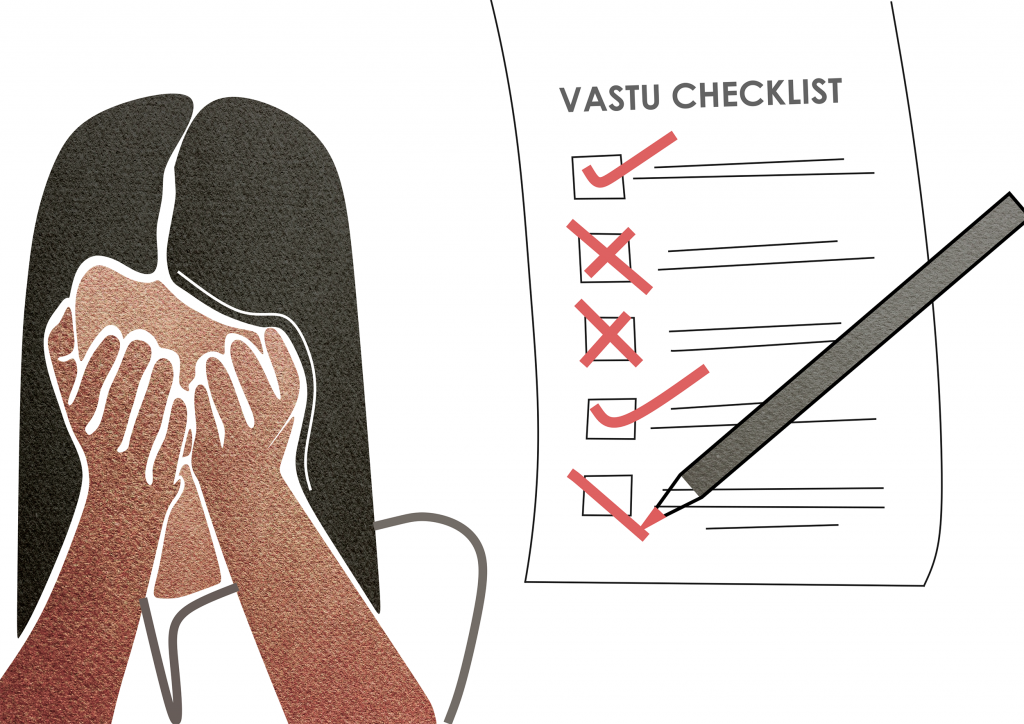vAstu is not a Rule Book
Student 1: In the last edition, we cleared a few myths and common fears about the vAstu of a house. In this edition we will be dealing with the myths surrounding selection of site and also to demystify vAstu by further discussing its origin.
Student 2: We will also be looking at vAstu from the point of view of an Architect and discuss the psychological or healing aspects of it.
Student 1: Ma’am, now that we are clear on the design aspects, we would like to know a few things about site selection. Does the shape of the site have any bearing at all? Is there any particular shape to choose or that we need to avoid? Why is it believed, for example, that a gou-mukhi is better than vAgra mukhi?
Ma’am: The shape of a land has certain symbolic meanings. We as humans respond to shape and form in a subconscious manner. Triangulated forms create an impact of tight energies, squares and rectangles give a feeling of balance and are called Satva shapes, pentagons give a feeling of movement and are called Rajasa shapes, and circles and ovals give a feeling of endless movement and are called Tamasa shapes.
In general, the vAstu texts have recommended only these geometric shapes for built forms since they offer very clear energetic inputs to the occupant. Any other non-geometric form in the plot has to be subdivided. There is no right or wrong here. The residential area or Gruha vAstu has to be marked within the plot so that it is rectangular or square in shape. The land around it is treated as open space or garden. This inner boundary can have a fence, a retaining wall, a short wall, or a green hedge. The idea is to protect this living space within a geometric form that offers stability and harmony.
Student 1: Hmmm… the common shapes definitely have a stabilising impact and it is quite possible to change the shape to suit us, but what about the slope, we cannot change that. Is it true that one should not select a site which is sloping from East to West?
Ma’am: The slopes too, have many meanings. Slope from South to North where South is higher is called susthana and is considered to be good for religious people and spiritual seekers. Land sloping from West to East with West higher is called sulabha and is considered to be good for people in political power. Land sloping from North to South with North higher is called vAstuvara and is considered to be good for people in business. Land sloping from East to West with East higher is called satpAda and is considered to be good for people in the service industry. Assuming that only the first type known as susthana is positive or preferred and good slope is very short sighted and impractical. With such wrong assumptions, 75% of all sloping lands will end up being un-suitable because of the un desirable slope!
Traditionally the slope was checked for an entire settlement and this is very critical. These settlements were usually located near a river or lake. Rain water catchment, flooding from adjacent water bodies, terracing of the land to channelise water for irrigation, understanding the monsoon directions and protecting the settlement from the heat of the summer have been very important. Therefore, different zones of the settlement had micro slopes that were part of the terrain. All this was very intelligently utilised by the designers or builders till almost few hundred years ago.
Student 2: Shapes and slopes are the most fundamental aspects to look at, but are there any other factors involved in site selection which are completely neglected in the modern planning or the site selection?
Ma’am: Definitely, today the Site plan is provided by the client to the designer. and so they have limited choice about the selection of site. Whereas, in the traditional architecture there was a very important role played by the designer in the site selection and also later in the elaborate process of site occupancy. In the traditional practice, the designer would observe the site at least for one season to ascertain whether the soil is fertile, whether it holds water and sustains life forms such as plants, birds and animals. Hence, to just decide whether site is good or bad without detailed analysis is unfair and hence must be avoided.
Student 1: Observing the site for one season, this seems so appropriate! It will be great to somehow implement these, in the time bound work and design situations we are in now a days, and then make an informed choice about the site considering all the aspects.
Student 2: Well, that is if we have the choice to select one. Most of us have to settle for apartments these days! So, can the vAstu principles be interpreted in terms of apartments too? Most of them claim to be vAstu compliant, how do we know if that’s not just a marketing strategy?
![]()
Ma’am: In case of an apartment or stacked buildings the vAstu inputs would be more elaborate. The overall principles that I have stated for a settlement will have to be referred also, for the entire complex, and the individual apartment will have to be analysed separately. Light, fresh air, protection from glare, open balconies and community spaces will have to be checked to understand a larger picture. Since vAstu also depends on the occupant and their specific lifestyle, corrections and healing can be recommended based on the overall analysis of the complex, apartment and its impact on the occupant.
vAstu is a multi-fold shastra and as mentioned it depends on the occupants and their relationship with the house, thus claiming a house to be vAstu compliant or otherwise, based only on a few thumb rules or a checklist is inappropriate, and surely seems more like a marketing strategy.
Student 1: I would agree too! Checking the vAstu compliance for an apartment will be a little complicated and tricky because we will have to scale it down to each individual apartment.
Student 2: But scaling it up and using vAstu principles to plan a settlement say a gated community or a township, should not be that complicated, right?
Ma’am: As mentioned in the earlier answer, the settlement or Gramam or Nagaram is the primary prototype of residential design. The individual residences were usually similar to Row houses and more or less identical in most parts of India. Larger mansions were also made in a standardised fashion that allowed easy replication.
Generally, all the directions of the settlement were seen as effective, and the overall layout defined the location of various facilities. Climate, slope, ground water availability and soil condition were important criteria for the design and construction. Certainly, this prototype of the traditional village or town can be used for designing new townships.
The form of the overall town was replicated in the micro unit of each zone, and further replicated into the micro unit of the individual residence. This concept of telescopic reduction or algorithmic nesting can be seen in its most refined form in the temple structure. The centre of the settlement was usually occupied by the temple, a sacred water pond or open maidAn. Residential buildings were not recommended adjacent to a temple.
Student 2: But these days we see a house next to a temple? Is that fine?
Ma’am: The reason for not building a residence adjoining a temple is two-fold. One is the size of the temple structure which would mean the depth of the foundation also. This could affect the adjoining properties adversely and cause cracks in the walls and lead to general instability. The second is based on the energy. Many people visit the temple and bring their sorrows to the feet of the Lord. Therefore there is a possibility of un-digested feelings, hopes, despair and anger to be affecting the atmosphere around the Temple precinct. This would definitely affect the adjacent properties. Traditionally there were gardens planned around these temples and nature absorbed the residual emotions effectively.
Student 1: Planning gardens around temples is such a beautiful and effective idea!
Is there any reference to landscaping in the traditional texts of vAstu? Is any specific tree or a plant considered suitable for a home?
Ma’am: Very simple guidelines have been given regarding trees and plants. Trees with hard core are recommended closer to the building and trees with soft cores are recommended at a distance from the walls. Similarly, large trees are recommended on the outer periphery and short trees closer to the building. These are practical suggestions to prevent trees falling and harming the structure and the deep roots breaking the walls at the level of the foundation. Flowers and aromatic plants have been recommended near the house.
Student 2: Interesting. I like this approach of understanding the principles! It makes much more sense now to me. I am sure there will be interest generated in exploring these areas and understanding the principles, especially from our community of Architects in India. They will have one concern though, that vAstu might restrict their creativity. Do the designers have to sacrifice their own creativity for the sake of culture and tradition?
![]()
Ma’am: It can be seen as a hinderance only if the rules and formulae are put into a straight jacket. But if the relevance of the climatic and lifestyle driven solutions is understood then there is infinite solutions and designs possible. In Indian classical music the understanding of the rAga, swara and tAla gives endless variations to the musician. The principles in the vAstu Shastra are similar to this.
Student 2: That’s a very insightful comparison between Music and Architecture! I do know that the nAtyashastra, a treatise on Indian dance drama says that Indian art forms are interconnected and it is impossible to completely understand one without touching upon another!
Student 1: And yet many look at vAstu as just a Hindu religious text or mere hearsay or at times just andh vishvas (Blind Faith)!
Ma’am: vAstu is a shastra. A shastra is a technical treatise or a manual. All science and technology related information in the earlier traditions were codified in the form of these shastras. For example, nAtya shastra and SangIta shastra, are some of the well-known texts. vAstu shilpa shastra dealt with residential architecture, town planning, making of furniture and vehicles and crafting of icons & implements. They are relevant and applicable to the traditions of Hinduism, Buddhism and Jainism, generally known as the Dharma traditions.
Student 2: Our ancestors were actually telling us to be creative and sensitive then? This seems like such a contrast to how people understand and interpret vAstu today – as a set of rigid rules and restrictions. Now I’m curious to know, who’s theory is this shAstra? Where can I find it?
Ma’am: shAstras are not ascribed to any single person. Usually they are compilations by one or more writers, and contain data from earlier theories and practices that were already in existence. For example, there is a very clear statement made by the author of ‘Manushyalayachandrika’, Shri. Tirumangalat Neelakanthan Musat that the text is a compilation from earlier shAstras such as Mayamatam, vAstuvidya, Kasyapa shAstra, Agama shAstra and so on. In general, unlike popular authors of today who generally hijack information without any acknowledgement, the earlier writers recorded all their sources meticulously!
The question then is, where did the earlier information come from? The earliest reference is always the Vedas and they are seen as the original repository of all knowledge and wisdom. In connection with the shAstra, even though the source is the Vedic texts, the field experience from the various practitioners must have been the springboard of the knowledge. There are many texts, with a lot of information and certain suggestions to follow…
- Mayamatam
- VishwakArmEyam
- KAshyapam
- ManushyAlaya chandrika
- SamarAngana sUtradhar
- NaradashilpashAstra
These are a few of the examples.
Originally there were 64 texts in samskrutam and scores of texts in regional languages. Only 32 have survived today. These texts speak about selection of a site, understanding the energies of a space, aesthetics and proportions, building technology, well-being and comfort and a great deal of information on materials and the maintenance of buildings. They are texts relating to design and the buildings.
Student 1: Thank you Ma’am for busting so many myths and demystifying vAstu. So, we now understand that vAstu is much more than just breaking walls and replacing doors and windows, it is a holistic approach to designing of spaces that will enhance and nurture good energies.
Student 2: But is it also possible to resolve any ongoing litigation to help transfer or sale of property issues by doing vAstu rectification? Also, how long should one wait to see the results of a vAstu correction?
Ma’am: There are simple rituals that have been specified to re energise an old building, to bring in new energies to a new building, prayers to heal the hurt and wounds, and finally to ward-off negative energies that may be causing legal and political problems to the inhabitants. The healing or correction may take a few days to few months.
What we need to keep in mind is that the patterns of energies that are occupying a space cannot be removed, but their potency can be reduced. The basic impact of the healing prayer is to assist in bringing the occupants to a state of balance and inner peace. More harm happens because of fear and anxiety than we are aware of! Prayer or yantra mantra and tantra regulates the energy transfer between people and the universal space, and assists in restoring the natural balance.
We, at Ritambhara, carry out chikitsa vAstu or healing of spaces along with the designing of new buildings based on the principles of vAstu shAstra.
Student 1: So, there you are! We hope this edition has helped you further in Demystifying vAstu. For any further personal queries do consult the team of experts at Ritambhara.
![]()
Blog Contributors: Amar, Innisai and Shivangi


 Anoop is a student of Yoga, an entrepreneur, a coach and a father of two young boys. He has led successful leadership stints in both the corporate and non-for-profit sectors. On encountering the country’s water/farmer crises at close quarters, he decided to pause and examine the impact various ‘isms’ – capitalism, colonialism, etc., were having on us as individuals, families, the society and the environment at large. This quest led him to formally engage with traditional Indic knowledge systems while also learning from the latest advances in science – about our physical and mental wellbeing, importance of body and mind work in healing trauma and the urgent need for a conscious rebuilding of family / work / social structures if we have to thrive individually and collectively. Insights, frameworks and processes gleaned from these on-going studies, an anchorage in his own personal practice and his wide-ranging experiences is what Anoop brings to facilitation/coaching spaces in Ritambhara and his various professional engagements.
Anoop is a student of Yoga, an entrepreneur, a coach and a father of two young boys. He has led successful leadership stints in both the corporate and non-for-profit sectors. On encountering the country’s water/farmer crises at close quarters, he decided to pause and examine the impact various ‘isms’ – capitalism, colonialism, etc., were having on us as individuals, families, the society and the environment at large. This quest led him to formally engage with traditional Indic knowledge systems while also learning from the latest advances in science – about our physical and mental wellbeing, importance of body and mind work in healing trauma and the urgent need for a conscious rebuilding of family / work / social structures if we have to thrive individually and collectively. Insights, frameworks and processes gleaned from these on-going studies, an anchorage in his own personal practice and his wide-ranging experiences is what Anoop brings to facilitation/coaching spaces in Ritambhara and his various professional engagements.
 Priya is a Yoga therapist in the Krishnamacharya tradition. She adapts Reiki & energy work, Vedic chanting, life coaching & Ayurvedic practices in her healing spaces. She is committed to nurturing collectives that have the praxis of Yoga at their heart.
Priya is a Yoga therapist in the Krishnamacharya tradition. She adapts Reiki & energy work, Vedic chanting, life coaching & Ayurvedic practices in her healing spaces. She is committed to nurturing collectives that have the praxis of Yoga at their heart. Anisha has been on an exploration to understand herself through yoga for the last 15years which led her to teaching yoga, yoga therapy and inner work through yoga.
Anisha has been on an exploration to understand herself through yoga for the last 15years which led her to teaching yoga, yoga therapy and inner work through yoga. Apoorva chanced upon Yoga in her early 20s. A spark was lit within and there was no turning back. Her exploration led her to the Krishnamacharya tradition more than a decade ago. Curious about human behaviour and what drives it, she was thrilled when her search ended (and also began) when she first came upon the Yoga Sutra, which illuminated a path towards answering many questions that had been held for a long time.
Apoorva chanced upon Yoga in her early 20s. A spark was lit within and there was no turning back. Her exploration led her to the Krishnamacharya tradition more than a decade ago. Curious about human behaviour and what drives it, she was thrilled when her search ended (and also began) when she first came upon the Yoga Sutra, which illuminated a path towards answering many questions that had been held for a long time. Anita is a yoga teacher and therapist in the tradition of Sri.T.Krishnamacarya and Sri T.K.V. Desikachar, a Reiki practitioner and a Life Coach. She is also the founder of Vishoka, a center for learning Indic and energy-based frameworks for living and healing. Her deep concern for human suffering and the problems of unsustainable living kept her on the path of seeking an integrated approach to looking at life, living, learning and healing.
Anita is a yoga teacher and therapist in the tradition of Sri.T.Krishnamacarya and Sri T.K.V. Desikachar, a Reiki practitioner and a Life Coach. She is also the founder of Vishoka, a center for learning Indic and energy-based frameworks for living and healing. Her deep concern for human suffering and the problems of unsustainable living kept her on the path of seeking an integrated approach to looking at life, living, learning and healing. Ankit is a seeker in the wisdom traditions of India. The core of his work includes creating dialogic spaces where people can look within and see the connection between their inner and outer lives. Inspired by the likes of Gandhi, Aurobindo, Vivekananda and Guru Gobind his experiments in service took him back to his roots in Punjab where he is creating a community-led model of higher education which is open, inclusive and accessible for all. Ritambhara for him is a space for engaging in a community which is committed to a DHramic life. He anchors his work of learning and leadership in the Antaranga Yoga Sadhana and the humanistic wisdom of Mahabharata.
Ankit is a seeker in the wisdom traditions of India. The core of his work includes creating dialogic spaces where people can look within and see the connection between their inner and outer lives. Inspired by the likes of Gandhi, Aurobindo, Vivekananda and Guru Gobind his experiments in service took him back to his roots in Punjab where he is creating a community-led model of higher education which is open, inclusive and accessible for all. Ritambhara for him is a space for engaging in a community which is committed to a DHramic life. He anchors his work of learning and leadership in the Antaranga Yoga Sadhana and the humanistic wisdom of Mahabharata.
If a common man want to construct the new house in villages in india , there was no well know vastu pandit near in his area .What is the best approach to construct the house with Vaastu. Please let me guide me aim facing this types of issue.